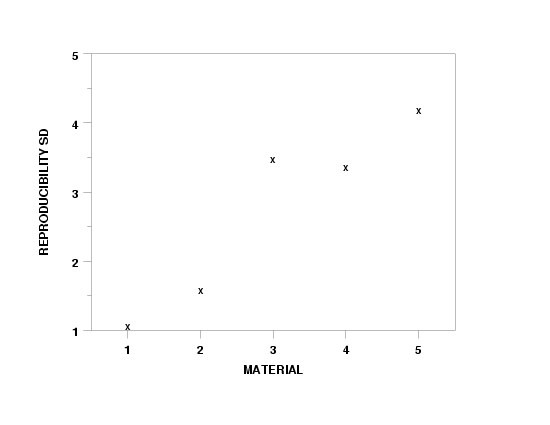REPRODUCIBILITY STANDARD DEVIATION
Name:
REPRODUCIBILITY STANDARD DEVIATION (LET)
Type:
Purpose:
Compute the reproducibility standard deviation of a variable
as defined by the ASTM E 691 - 99 standard.
Description:
The reproducibility standard deviation is a core concept
defined in the ASTM E 691 - 99 standard. This standard
is described in detail in the following document:
"Standard Practice for Conducting an Interlaboratory Study
to Determine the Precision of a Test Method", ASTM
International, 100 Barr Harbor Drive, PO BOX C700,
West Conshohoceken, PA 19428-2959, USA.
This document describes reproducibility in the following way.
Reproducability is the variability between single test
results obtained in different laboratories, each of which
has applied the test method to test specimens taken at
random from a single quantity of homogeneous material.
The reproducibility standard deviation is computed as
with
|
sR*
|
=
|
\( \sqrt{s_{\bar{x}}^2 + s_{r}^2 \frac{n-1}{n}} \)
|
|
\( s_{\bar{x}} \)
|
=
|
standard deviation of the cell averages
|
|
n
|
=
|
cell sample size (currently, equal cell sizes
expected)
|
and sr denoting the repeatability standard
deviation
\( s_r = \sqrt{\sum_{i=1}^{p}{s_{i}^2}/p} \)
with p and si denoting the number of
laboratories and the standard deviation of the i-th
laboratory, respectively.
In an interlaboratory study, the reproducibility standard
deviation is computed for each material.
Syntax:
LET <par> = REPRODUCIBILITY STANDARD DEVIATION
<y> <labid>
<SUBSET/EXCEPT/FOR qualification>
where <y> is a response variable;
<labid> is a lab-id variable;
<par> is a parameter where the reproducibility
sd value is saved;
and where the <SUBSET/EXCEPT/FOR qualification> is optional.
Examples:
LET RSD = REPRODUCIBILITY STANDARD DEVIATION Y LAB
LET RSD = REPRODUCIBILITY STAND DEVI Y LAB SUBSET MAT = 1
Note:
Default:
Synonyms:
Related Commands:
|
E691 INTERLAB
|
= Perform an E691 interlab analysis.
|
|
REPEATABILITY STANDARD DEVIATION
|
= Compute the repeatability standard deviation.
|
Reference:
"Standard Practice for Conducting an Interlaboratory Study
to Determine the Precision of a Test Method", ASTM
International, 100 Barr Harbor Drive, PO BOX C700,
West Conshohoceken, PA 19428-2959, USA.
Applications:
Implementation Date:
Program:
SKIP 25
READ GLUCOSE.DAT Y LABID MATID
.
LET MATDIST = DISTINCT MATID
LET NMAT = SIZE MATDIST
XLIMITS 1 NMAT
MAJOR XTIC MARK NUMBER NMAT
MINOR XTIC MARK NUMBER 0
XTIC OFFSET 0.5 0.5
Y1LABEL REPRODUCIBILITY SD
X1LABEL MATERIAL
LINE BLANK
CHARACTER X
.
REPRODUCIBILITY SD PLOT Y LABID MATID

|
Privacy
Policy/Security Notice
Disclaimer |
FOIA
NIST is an agency of the U.S.
Commerce Department.
Date created: 04/20/2005
Last updated: 10/07/2016
Please email comments on this WWW page to
[email protected].
|
|


